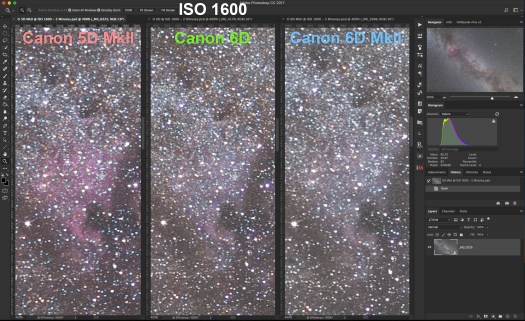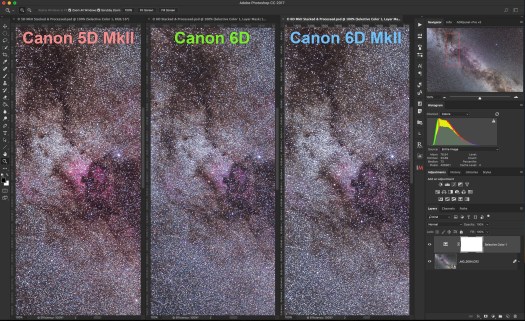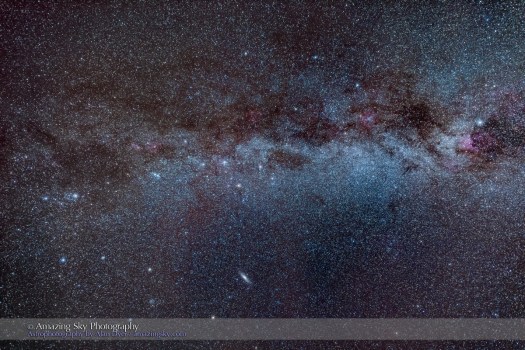
Following up on my earlier tests, I compare the new Canon 6D MkII camera to earlier Canon full-frame models in long, tracked exposures of the Milky Way.
A month ago I published tests of the new Canon 6D MkII camera for nightscape images, ones taken using a fixed tripod in which exposures usually have to be limited to no longer than 30 to 60 seconds, to prevent star trailing.
Despite these short exposures, we still like to extract details from the dark shadows of the scene, making nightscape images a severe test of any camera.
I refer you to my August 9, 2017 blog Testing the Canon 6D MkII for Nightscapes for the results. The 6D MkII did not fare well.
Here I test the 6D MkII for what, in many respects, is a less demanding task: shooting long exposures of deep-sky objects, the Milky Way in Cygnus in this case.
Why is this an easier task? The camera is now on a tracking mount (I used the new Sky-Watcher Star Adventurer Mini) which is polar aligned to follow the rotation of the sky. As such, exposures can now be many minutes long if needed. We can give the camera sensor as much signal as the darkness of the night sky allows. More signal equals less noise in the final images.
In addition, there are no contrasty, dark shadows where noise lurks. Indeed, the subjects of deep-sky images are often so low in contrast, as here, they require aggressive contrast boosting later in processing to make a dramatic image.
While that post-processing can bring out artifacts and camera flaws, as a rule I never see the great increase in noise, banding, and magenta casts I sometimes encounter when processing short-exposure nightscape scenes.



• Canon 6D MkII (2017)
• Canon 6D (2012)
• Canon 5D MkII (2008)
Note that the 5D MkII has been “filter-modified” to make its sensor more sensitive to the deep red wavelengths emitted by hydrogen gas, the main component of the nebulas along the Milky Way. You’ll see how it picks up the red North America Nebula much better than do the two off-the-shelf “stock” cameras. (Canon had their own factory-modified “a” models in years past: the 20Da and 60Da. Canon: How about a 6D MkIIa?)
I shot at four ISO speeds typical of deep-sky images: 800, 1600, 3200, and 6400.
Exposures were 4 minutes, 2 minutes, 1 minute, and 30 seconds, respectively, to produce equally exposed frames with a histogram shifted well to the right, as it should be for a good signal-to-noise ratio.
Noisy deep-sky images with DSLR cameras are usually the result of the photographer underexposing needlessly, often in the mistaken belief that doing so will reduce noise when, in fact, it does just the opposite.
The above set of three images compares each of the three cameras at those four ISO speeds. In all cases I have applied very little processing to the images: only a lens correction, some sharpening, a slight contrast and clarity increase, and a slight color correction to neutralize the background sky.
However, I did not apply any luminance noise reduction. So all the images are noisier than what they would be in a final processed image.
Even so, all look very good. And with similar performance.
All frames were shot with Long Exposure Noise Reduction (LENR) on, for an automatic dark frame subtraction by the camera. I saw no artifacts from applying LENR vs. shots taken without it.
The 6D and 6D MkII perhaps show a little less noise than the old 5D MkII, as they should being newer cameras.
The 6D MkII also shows a little less pixelation on small stars, as it should being a 26 megapixel camera vs. 20 to 21 megapixels for the older cameras. However, you have to examine the images at pixel-peeping levels to see these differences. Nevertheless, having higher resolution without the penalty of higher noise is very welcome.



The new 6D MkII shows very similar levels of noise to the 6D, perhaps improving upon the older cameras a tad.
Because images are well-exposed (note the histogram at right), the 6D MkII is showing none of the flaws of its lower dynamic range reported elsewhere.
That’s the key. The 6D MkII needs a well-exposed image. Given that, it performs very well.

The lead image at the very top is a final full-frame image with the Canon 6D MkII.
As such, based on my initial testing, I can recommend the Canon 6D MkII (and plan to use it myself) for deep-sky photography.
Indeed, I’ll likely have the camera filter-modified to replace my vintage yet faithful 5D MkII for most of my deep-sky shooting. The 6D MkII’s tilting LCD screen alone (a neck, back, and knee saver when attached to a telescope!) makes it a welcome upgrade from the earlier cameras.
The only drawback to the 6D MkII for deep-sky work is its limited dark frame buffer. As noted in my earlier review, it can shoot only three Raw files in rapid succession with Long Exposure Noise Reduction turned on. The 5D MkII can shoot five; the 6D can shoot four. (A 6D MkIIa should have this buffer increased to at least 4, if not 8 images.)
I make use of this undocumented feature all the time to ensure cleaner images in long deep-sky exposures, as it produces and subtracts dark frames with far greater accuracy than any taken later and applied in post-processing.
I hope you’ve found this report of interest.
With the 6D MkII so new, and between smoky skies and the interference of the Moon, I’ve had only one night under dark skies to perform these tests. But the results are promising.
For more tips on deep-sky imaging and processing see my pages on my website:
Ten Steps to Deep-Sky Processing
Thanks and clear skies!
— Alan, September 7, 2017 / © 2017 Alan Dyer / amazingsky.com



